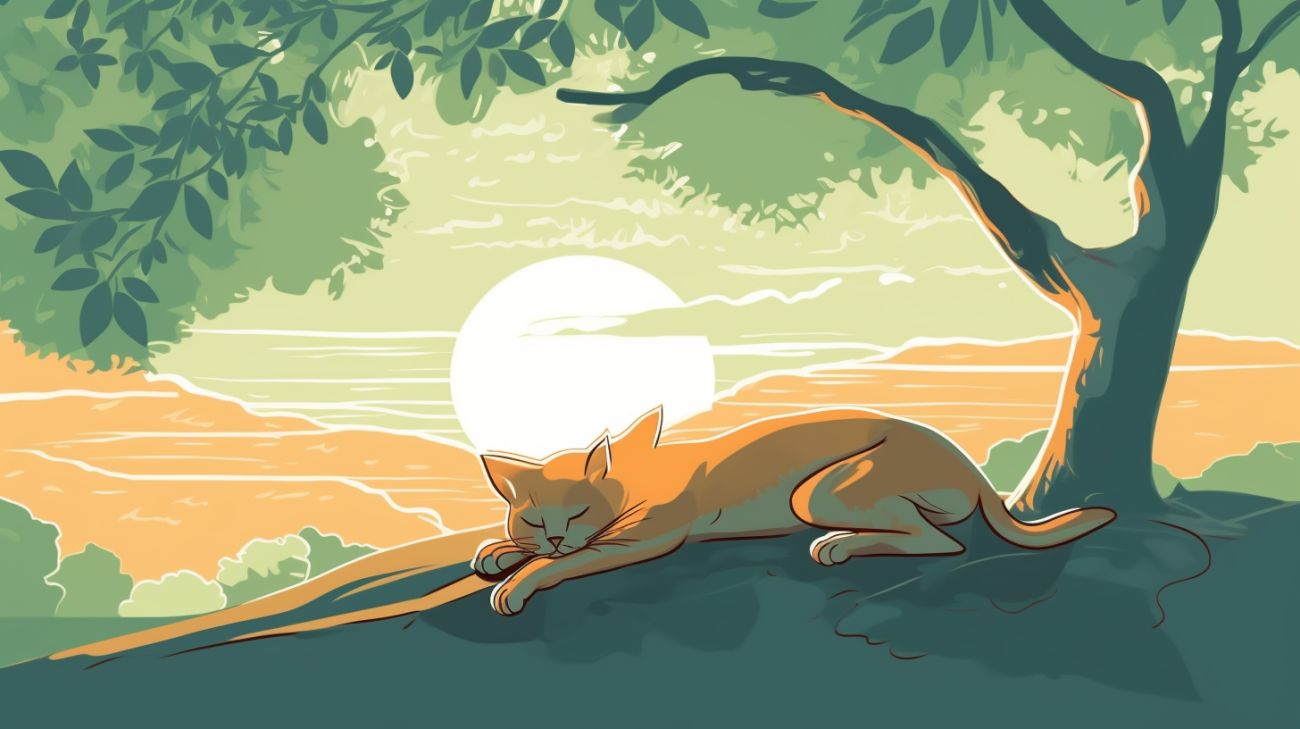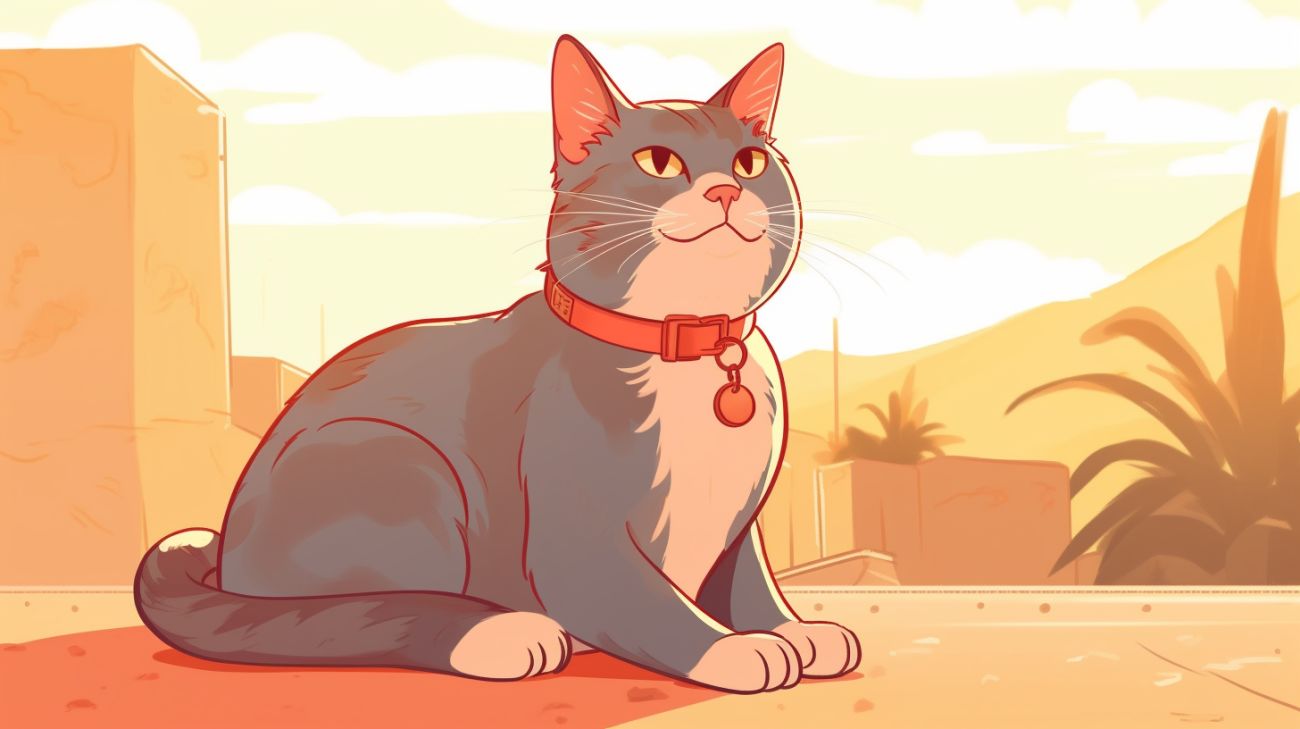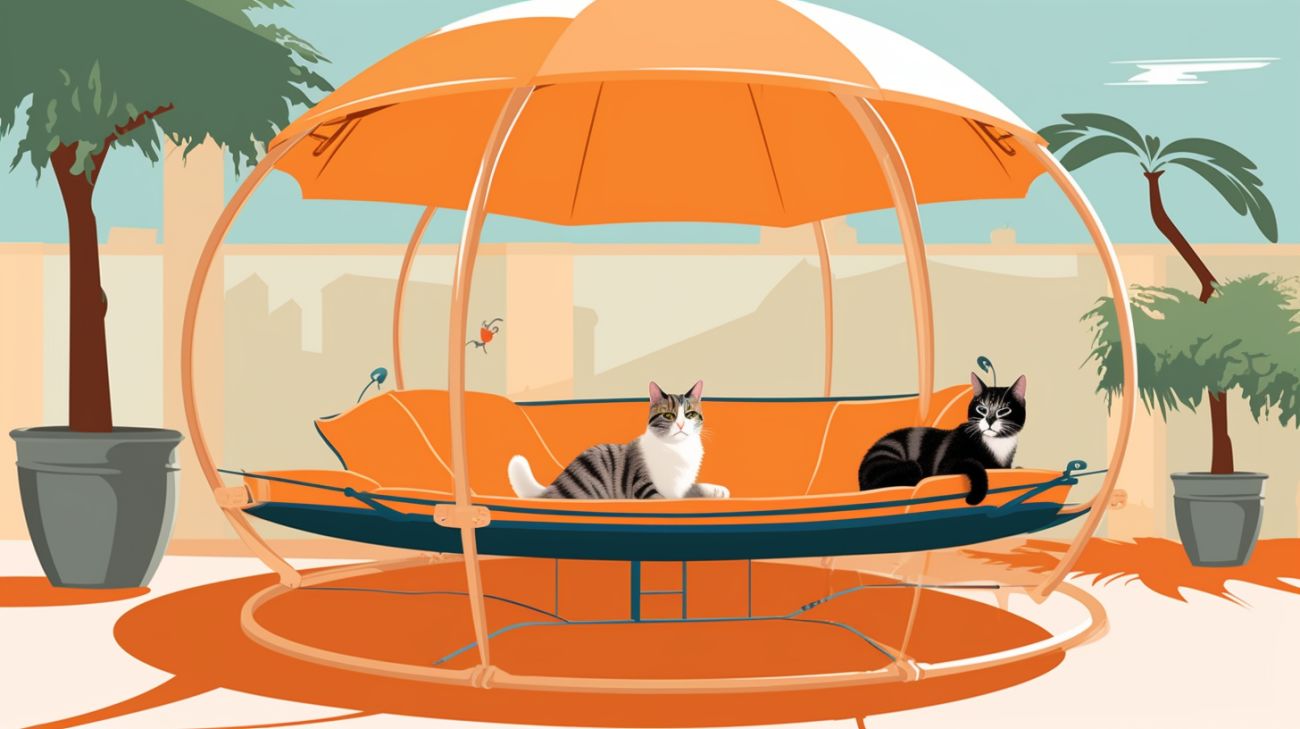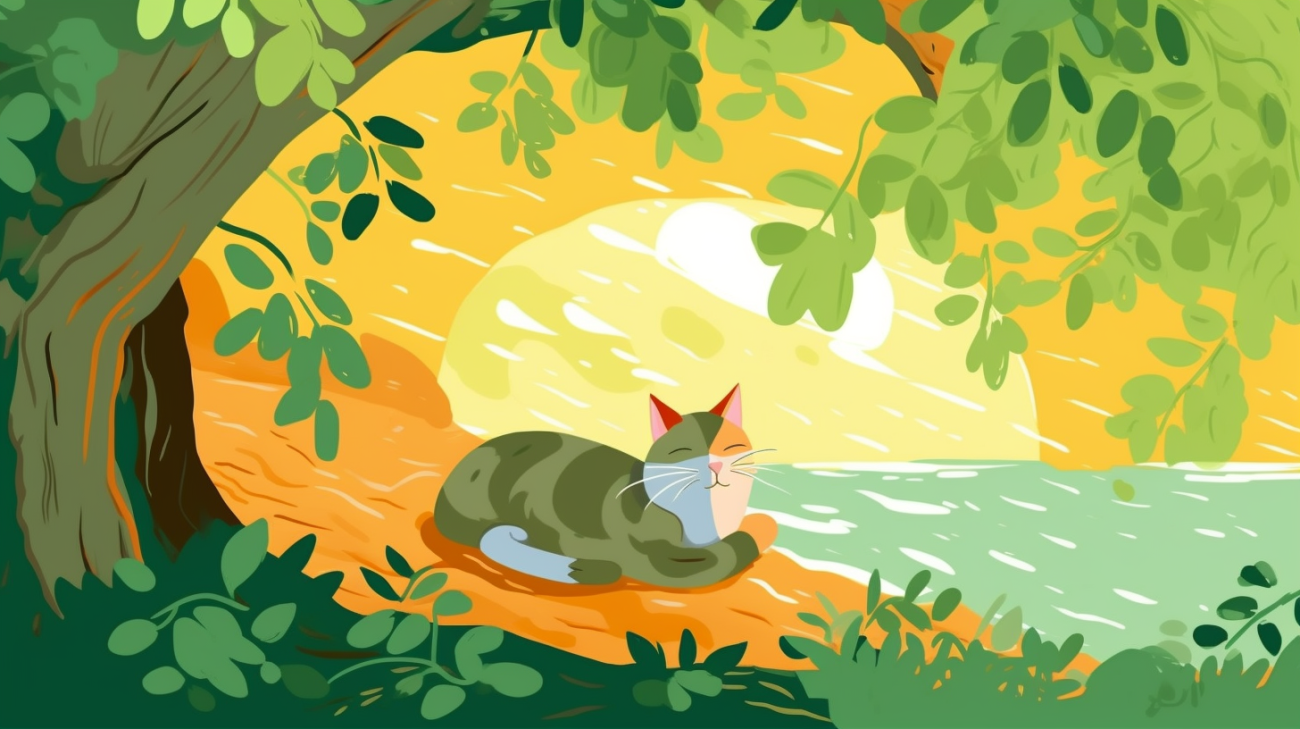Quick Navigation
How Heat Affects Cats' Behavior
Cat panting in the heat
Cats are sensitive creatures, particularly affected by high temperatures.
Cats Seeking Shelter
Under bushes or dense foliage: These areas can provide natural shade and a cool place to rest.
Inside garages, sheds, or other outbuildings: These structures can offer cooler temperatures and protection from the sun.
Under cars or other vehicles: Cars can cast large shadows, providing a shady spot for cats to hide.
In cool, damp areas, like near water sources or in the shade of trees: These locations can be significantly cooler than the surrounding environment.
In crawl spaces, under porches, or in other shaded areas around your home: Cats may seek shelter close to home if they can find a suitable spot.

Increased Thirst and Dehydration Risks
Signs of dehydration in cats:
Lethargy or weakness: A dehydrated cat may be less active than usual.
Sunken eyes: This can be a sign of fluid loss.
Dry, tacky gums: Healthy cat gums should be moist and pink.
Loss of skin elasticity: Pinch your cat's skin gently; it should spring back quickly when released.
Decreased urination: Monitor your cat's litter box usage for changes.
Panting: Cats usually pant to cool themselves when they're overheated or dehydrated.

Hot weather can cause cats to become dehydrated more quickly.
Altered Sleep Patterns

Heatstroke in Cats: Symptoms and Treatment
Panting or open-mouthed breathing: Cats may pant to cool themselves, but excessive panting can be a sign of heatstroke.
Excessive drooling: This can be a sign of overheating and discomfort.
Bright red gums and tongue: Healthy cat gums should be pink, not red.
Rapid or irregular heartbeat: This can indicate distress and overheating.
Weakness or unsteady gait: Cats suffering from heatstroke may struggle to maintain their balance.
Vomiting or diarrhea: Gastrointestinal upset can be a sign of heat stress.
Lethargy or unresponsiveness: Severe heatstroke can cause a cat to become unresponsive.
Heatstroke is a serious concern for cats during hot weather.
1.
Move your cat to a cooler area immediately, such as an air-conditioned room or a shaded spot outdoors.
2.
Offer your cat cool (not cold) water to drink, but don't force them to drink if they're not interested.
3.
Apply cool, wet towels or washcloths to your cat's fur, focusing on their paws, groin, and neck. Avoid using ice or ice-cold water, as it can constrict blood vessels and slow down the cooling process.
4.
Use a fan to help circulate cool air around your cat.
5.
Monitor your cat's body temperature with a rectal thermometer. Aim to lower their temperature to around 103°F (39°C).
6.
Once your cat's temperature has stabilized, contact your veterinarian for further advice and follow-up care. If your cat has gone missing during hot weather, check out our guide on how to find a lost cat outside for expert tips on locating your furry friend.

The Effect of Hot Weather on a Cat's Appetite

Tips for Finding a Cat Missing in Hot Weather
Expand Your Search Radius
Searching for a cat in a wider area during hot weather
Checking Local Shelters and Vet Offices
Contacting a local shelter to find a missing cat in hot weather
Leverage Social Media and Community Resources
Using social media to find a missing cat in hot weather
Don't Forget to Search at Night
Searching for a cat at night during hot weather
How to Approach a Frightened Cat That's Been Missing in Hot Weather
Stay calm and quiet: When approaching your cat, remain calm and speak in a soft, gentle voice. Avoid making sudden movements or loud noises, which could scare them further.
Get down to their level: Crouch down or sit on the ground to appear less threatening to your cat. This can help them feel more at ease and be more receptive to your presence.
Offer food or treats: Bring along some of your cat's favorite treats or a bit of wet food. This can help entice them to come closer, and it's also a great way to reward them for returning to you.
Use a familiar item: If possible, have something familiar with you, like a blanket or a toy, that carries your scent. This can help reassure your cat that they're safe and in friendly company.
Give them space: Don't force your cat to come to you. Instead, give them the chance to approach you on their terms. If they seem hesitant, try backing away slightly and allowing them to come closer at their own pace.
Stay calm and quiet when approaching a frightened cat that's been missing in hot weather.
Preventing Your Cat from Going Missing in Hot Weather
Provide Access to Fresh Water and Cool Shelter
Provide multiple water sources: Place several bowls of fresh water around your home, both inside and outside, to encourage your cat to drink more.
Offer a cooling mat: Cooling mats, which can be found at pet stores, help regulate your cat's body temperature and provide a comfortable place for them to rest.
Use fans or air conditioning: Keep your home cool with fans or air conditioning, and make sure there are spots near these cooling sources where your cat can lounge.
Create shaded areas: If your cat spends time outdoors, provide shade with umbrellas, awnings, or large leafy plants.
Encourage use of cooler surfaces: Tile or linoleum floors can be much cooler than carpet, so encourage your cat to rest on these surfaces by placing a soft blanket or cushion on them.
Cats can't sweat like humans and rely on other methods to regulate their body temperature.
Secure Windows and Doors
Install window screens: Fit screens on all windows that you plan to open. Make sure they're tightly secured and check for any gaps or damage that might allow your cat to slip through.
Check door latches: Ensure that all door latches and locks are functioning properly. Sometimes, cats can be quite clever in opening doors that aren't secured tightly.
Use pet-proof door guards: Consider installing door guards to keep your cat from squeezing through partially open doors.
Educate family members and guests: Make sure everyone in your household is aware of the importance of keeping doors and windows closed, especially during hot weather. Teach children to be cautious when entering or exiting the house, and remind guests not to let your cat slip out. To understand more about why cats might escape, check out common reasons for cat disappearance.

Use a Collar with ID Tags
Opt for a breakaway collar: Breakaway collars are designed to release if your cat gets snagged on something, preventing injury. Make sure the collar fits snugly but comfortably, with enough room to slip two fingers between the collar and your cat's neck.
Include essential information: The ID tag should display your cat's name, your phone number, and any important medical information (e.g., if your cat requires daily medication). Remember to keep the information up to date.
Consider adding a microchip: In addition to a collar and ID tag, consider microchipping your cat for an extra layer of protection. This permanent form of identification can be scanned by most shelters and vet offices, helping reunite you with your cat even if they lose their collar.

Preventing Escapes During Summer Parties and Gatherings
Inform your guests: Let your guests know about your cat, and kindly ask them to be mindful when entering or exiting your home to avoid accidental escapes.
Designate a safe room: Set up a quiet, comfortable room for your cat with food, water, and a litter box. Keep the door closed to prevent your cat from wandering into the party area.
Check on your cat periodically: Visit your cat throughout the event to ensure they're comfortable and not stressed. If they're feeling calm, you can even offer a few reassuring pets.
Use baby gates or barriers: Set up baby gates or barriers to limit your cat's access to certain areas of your home, like open doors or windows.
Consider a temporary ID tag: If you're hosting an event, consider attaching a temporary ID tag to your cat's collar with your phone number, just in case they manage to slip out unnoticed. If your cat does go missing, read our guide on how to find a lost cat outside.

Creating a Cat-Safe Outdoor Enclosure for Hot Weather
Choose a shady location: Make sure the enclosure is located in a shady area to protect your cat from excessive heat and sun exposure.
Secure the perimeter: Ensure the enclosure has sturdy walls and a secure roof to prevent escapes and protect your cat from potential predators.
Add enrichment items: Include scratching posts, platforms, and hiding spots to keep your cat entertained and comfortable. Learn more about cat hiding places to ensure your cat has a variety of options.
Provide fresh water and shelter: Offer a constant supply of fresh water and a sheltered area for your cat to escape the sun and heat.
Regularly inspect the enclosure: Regularly check the enclosure for any potential hazards, such as sharp edges, loose wires, or broken latches. To keep your cat safe from getting lost or injured, read our article on why cats run away and how to prevent it.

Adjusting Your Cat's Daily Routine During Hot Weather to Minimize Risks
Limit outdoor time during peak heat hours: Schedule outdoor playtime in the early morning or evening when temperatures are cooler.
Offer indoor activities: Encourage your cat to play and exercise indoors with interactive toys and games. If you need ideas, check out our how to find a cat in your house article for suggestions.
Monitor your cat's comfort: Keep an eye on your cat for signs of overheating or discomfort, and adjust their activities accordingly.
Change feeding times: Consider adjusting your cat's feeding schedule to coincide with cooler hours of the day.
Keep a consistent routine: Establish a consistent daily routine to help your cat feel secure and prevent them from seeking new adventures outside. If your cat has recently gone missing and returned, learn about what to do after your cat comes back.
A consistent daily routine helps your cat feel secure and prevents them from seeking new adventures outside.

FAQ
What are the signs that a cat is dehydrated?
Dehydration in cats may be indicated by sunken eyes, lethargy, dry gums, decreased skin elasticity, and concentrated urine. If you suspect dehydration, consult a vet immediately.
How can I help my cat stay cool during hot weather?
Provide fresh water, create cool resting areas, offer wet food, use a fan or air conditioner, and brush your cat regularly to reduce excess fur.
How long should I wait before starting to search for my missing cat?
Don't wait—begin searching as soon as you notice your cat is missing. The quicker you act, the higher the chances of finding your furry friend. For more information, read our guide on how long should my cat be missing before I worry.
Are certain cat breeds more prone to going missing in hot weather?
Some breeds, like Persians or Maine Coons, might be more sensitive to heat due to their long fur, but all cats can be affected by hot weather.
How can I train my cat to stay close to home during hot weather?
Implement a consistent routine, offer indoor enrichment, and consider creating a safe outdoor enclosure to keep your cat entertained and secure. Learn about cat hide adventures to better understand their behavior.
Should I use a GPS tracker for my cat during hot weather months?
A GPS tracker can provide peace of mind and help locate your cat quickly if they go missing. Just ensure the device is lightweight and comfortable for your cat. Discover how to track a cat with various techniques.
Can I use a humane trap to help catch my missing cat?
Yes, humane traps can be helpful. Set the trap with your cat's favorite food or bedding to entice them, and check the trap frequently to ensure their safety. If you're unsure about how to proceed, read our guide on how to trap a lost cat.
What should I do if I find a cat that isn't mine during my search?
If you find a lost cat, check for an ID tag, scan for a microchip, report the cat to local shelters and vet offices, and use social media to reunite the cat with its owner. If you believe the cat may have been stolen, learn more about pet theft laws and regulations.


